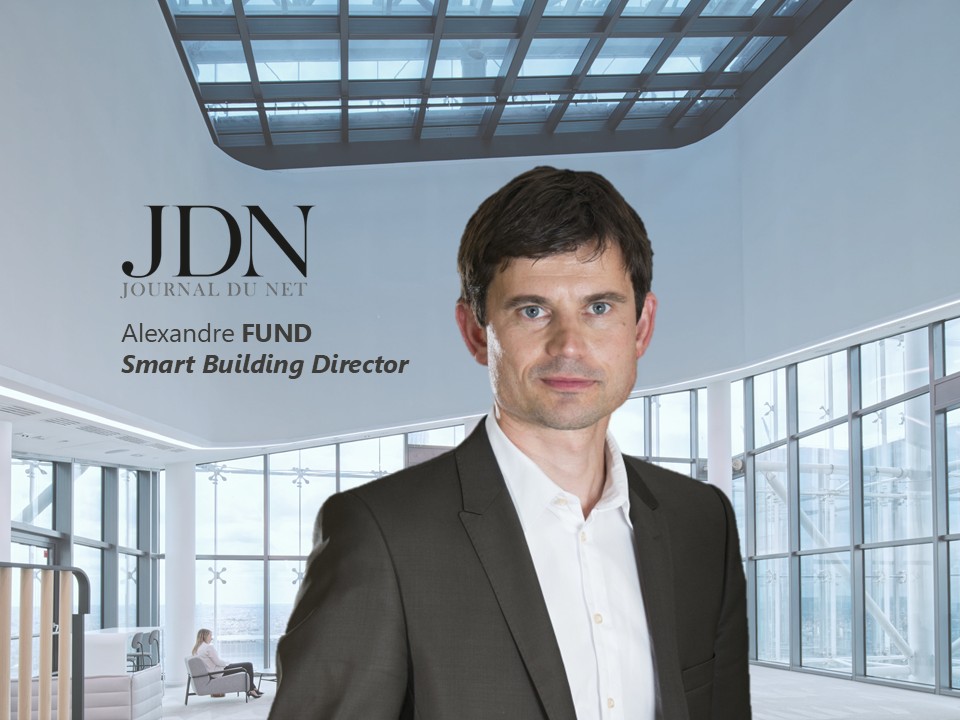Opinion piece published Le Journal du Net on 24 November 2025.
A veritable micro-city within the city, hospitals occupy a special place in the world of smart cities. They face a number of technical, organisational and human challenges, such as coordinating thousands of flows – patients, caregivers, visitors, emergency vehicles, etc. – while ensuring safety, quality of service and energy efficiency. In this context, how can BIM (Building Information Modelling), AI (Artificial Intelligence), BOS (Building Operating System) and digital twins become catalysts for bringing hospitals into the age of intelligence, while strengthening their integration into the urban ecosystem? Some answers are illustrated here by the Nantes University Hospital project. They highlight issues that, beyond this example, are relevant to all university hospitals in France.
A digital twin for a hospital on the move
We often tend to forget it, but hospitals are living organisms: they are subject to constant redevelopment, whether it be to accomodate new technical platforms or to adapt to health or regulatory constraints. This requires the ability to design and operate them with dynamic mapping powered by constantly updated data. Every transformation – whether it is a simple change of partition, the addition of a treatment room or the reallocation of an entire department – modifies the operational configuration of the site and requires the reorganisation of flows – patients, visitors, technical teams – in real time. This is precisely what BOS and its operational extension, the digital twin, make possible. Healthcare facility managers can therefore visualise, analyse and control their entire hospital campus, from the building scale to the district scale.
The example of the new Nantes University Hospital illustrates this development tangibly. This vast hospital complex, currently under construction, is based on BIM digital models that centralise all the structural and technical information about the site. The hypervisor is enriched by dynamic real-time data (from sensors, technical and hospital information systems, and communicating equipment), enabling continuous monitoring and action. As a result, the hospital has a comprehensive, up-to-date view of its infrastructure, a decisive advantage for managing a constantly evolving site.
Intelligent scenarios for responsiveness
As is well known, healthcare facilities must be able to respond to the unexpected. This is the case, for example, when a medical helicopter arrives on the site. Thanks to digital twins and intelligent agents, some hospitals can automatically activate runway lighting, reserve a priority lift and secure certain access points. This entire system allows healthcare facility managers to oversee operations in real time, thereby improving their responsiveness and ensuring continuity of care. In some hospitals, pedestrian flows can also be redirected in the event of a technical incident, or lifts can be allocated intelligently to avoid congestion between departments. This finely tuned orchestration significantly reduces response times in an environment where every second counts.
Flow optimisation
In hospital campuses, particularly very large ones, orientation is a critical issue for all user profiles. With interactive mapping and indoor guidance tools, patients and visitors can easily find their way around. Care staff have access to optimised routes that take specific constraints into account, such as reserved lifts, sterile areas, logistics robot movements, etc. Streamlining movement, BIM, digital twins and hypervisors contribute directly to the operational efficiency of healthcare facilities. Some hospitals already offer highly advanced services to patients and visitors. Visitors can plan their route to a consultation room, receive notifications in the event of a change of location or delay, and be guided in real time via photorealistic 3D maps.
On this subject, the new Nantes University Hospital intends to provide a centralised digital portal offering a personalised experience dedicated tor caregivers, technicians and administrators. Technicians, for example, will have instant access to technical documentation for each room and receive alerts about maintenance work that needs to be carried out.
Intelligent and secure energy management
Because it operates 24/7, houses energy-intensive medical equipment (MRI machines, scanners, operating theatres), and requires constant ventilation and air treatment to ensure optimal sanitary conditions, hospitals remain among the largest energy consumers in a city. Thanks to BIM and BOS (Building Operating System), a comprehensive hospital information system, it is possible to view the building’s energy consumption in real time and optimise its use. The BOS allows data from different systems to converge within a single repository. On the one hand, there is building data linked, for example, to the BMS (Building Management System): comfort, energy, intercom, video surveillance, lifts, fire detection, etc. On the other hand, there is usage data related to various service applications: access control, visitor reception, workstation reservations, meeting organisation, occupancy management, concierge services, etc. This makes it possible, for example, to trigger corrective or preventive actions, such as automatically adjusting the temperature according to the actual occupancy of the areas.
This approach is at the heart of the Smart Hospital project for the new Nantes University Hospital, where BIM is integrated into a strategy for enhanced environmental performance.
In other hospitals, energy management can extend to detailed temperature control based on usage (occupied or unoccupied areas, type of medical activities, etc.), lighting optimisation and proactive detection of energy waste. Ultimately, these features will help to significantly reduce the carbon footprint of these establishments, bringing hospitals in line with the idea of a sustainable city.
Digital security: an essential pillar of the smart hospital
As hospitals transform into digital ecosystems, cybersecurity is becoming a major strategic issue. The integration of connected objects, technical and information systems, and decision-making tools increases exposure to threats. This hyperconnectivity, particularly with urban infrastructure, requires security to be considered from the design stage onwards, in what is known as the “security by design” approach: rigorous access management, continuous monitoring and the ability to respond quickly to attacks. These requirements, reinforced by regulatory frameworks such as the European NIS2 directive, which imposes increased cybersecurity obligations on so-called ‘essential’ sectors, including healthcare, determine the ability of Smart Hospitals to guarantee their resilience, data confidentiality and continuity of care in an increasingly digital environment.
Integration into the environment
Although this is not yet the case for the new Nantes University Hospital, hospitals can interact with their environment at the smart city level, with access and car park management linked to urban mobility, integration of civil security alerts, and optimisation of logistics circuits with city networks. The digital twin makes possible this interconnection, making the hospital a fully-fledged part of the smart city, for example by linking internal flows with local public transport to streamline the arrival of patients and visitors. This coordination could eventually extend to the management of emergency vehicles in the city, in order to ensure optimised routes during peak periods.
Supporting change
Implementing these technologies requires human and organisational support. Hospital teams must take ownership of these tools and processes must evolve towards greater cross-functionality, moving beyond siloed approaches. Only then can hospitals become more agile, more resilient and better equipped to meet the healthcare, service and environmental challenges of tomorrow. What if the Building Operating System and its digital twin became the true digital brains of the hospital of the future?
For the new Nantes University Hospital, even if it is not yet a reality across the board, this is the direction pursued by the hypervision project that has been implemented. This project lays the foundations for a digital environment that will optimise the management of the building, digital data and information exchanges between technical systems. Ultimately, this will allow the project to expand into all dimensions of the Smart Hospital concept.
By Alexandre Fund, Smart Building Director, Kardham Digital.

